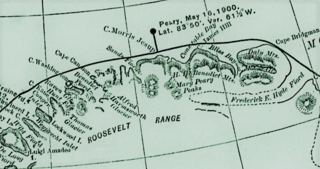
The Innuitian Mountains are a mountain range in Nunavut and the Northwest Territories, Canada. They are part of the Arctic Cordillera and are largely unexplored, due to the hostile climate. They are named after the northern indigenous people, the Inuit. In some locations the Innuitian Mountains measure over 2,500 m (8,202 ft) in height, and 1,290 km (802 mi) in length. The highest point is Barbeau Peak on Ellesmere Island at 2,616 m (8,583 ft). There are no trees and minimal wildlife in the Innuitian Mountains due to the harsh cold climate as well as being located north of the Arctic tree line. This region is mostly barren with vast areas of permafrost. There are metallic mineral resources including iron and zinc and fossil fuel resources such as coal.
The Arctic Lands is a physiographic region located in northern Canada. It is one of Canada's seven physiographic regions, which is divided into three divisions—the Innuitian Region, Arctic Coastal Plain, and Arctic Lowlands.

The Arctic Cordillera is a terrestrial ecozone in northern Canada characterized by a vast, deeply dissected chain of mountain ranges extending along the northeastern flank of the Canadian Arctic Archipelago from Ellesmere Island to the northeasternmost part of the Labrador Peninsula in northern Labrador and northern Quebec, Canada. It spans most of the eastern coast of Nunavut with high glaciated peaks rising through ice fields and some of Canada's largest ice caps, including the Penny Ice Cap on Baffin Island. It is bounded to the east by Baffin Bay, Davis Strait and the Labrador Sea while its northern portion is bounded by the Arctic Ocean.
The Princess Margaret Range, also called the Princess Margaret Mountains, are a mountain range on Axel Heiberg Island in Nunavut, Canada. The range is one of the most northern ranges in the world and of the Arctic Cordillera. The highest mountain in the range is Outlook Peak at 2,210 m (7,251 ft). The range has an area of 42,865 km2 (16,550 sq mi).
The Innuitian Region is a physiographic division of Canada's far north. It is one of three physiographic divisions of the Arctic Lands physiographic region, along with the Arctic Coastal Plain, and the Arctic Lowlands.The Queen Elizabeth Islands comprise most of the region, which is also considered to be part of the Arctic Archipelago.
Disraeli Glacier is a glacier on northern Ellesmere Island, Nunavut, Canada. It lies in Quttinirpaaq National Park, South-West of the Disraeli Fiord. It is believed to have been named after Benjamin Disraeli, a British politician in the mid 1800s.
Van Hauen Pass is a mountain pass on northwestern Ellesmere Island, Nunavut, Canada.
The Boulder Hills are a mountain range in northeastern Quttinirpaaq National Park, Ellesmere Island, Nunavut, Canada. It is associated with the Arctic Cordillera mountain system.
Wulff Land is a peninsula in far northwestern Greenland. Administratively it is a part of the Northeast Greenland National Park.
Bessel Fjord is a fjord in northwestern Greenland. Administratively it belongs to the Avannaata municipality.
Helvetia Tinde is the highest mountain in the Roosevelt Range, Northern Greenland. It is also the highest mountain of the northernmost mountain range on Earth.

The Roosevelt Range or Roosevelt Mountains is a mountain range in Northern Greenland. Administratively this range is part of the Northeast Greenland National Park. Its highest peak is the highest point in Peary Land.

Nansen Land is a peninsula in far northwestern Greenland. It is a part of the Northeast Greenland National Park.
The Eurekan orogeny was a Phanerozoic mountain building event that affected the eastern portion of the Arctic Archipelago and, to a lesser extent, northern Greenland. Deformation initiated in the Late Cretaceous, during which time the Sverdrup Basin began to fragment and fold in response to the counterclockwise rotation of Greenland, caused by seafloor spreading in the Canadian Arctic Rift System. Isostatic uplift was most pronounced in the Grantland Mountains and Victoria and Albert Mountains on Ellesmere Island and in the Princess Margaret Range on Axel Heiberg Island, as evidenced by the current physiography. Compression in a broad zone on Ellesmere Island resulted in the formation of the Eurekan Fold Belt.

Roosevelt Land is a peninsula in far northern Greenland. It is a part of the Northeast Greenland National Park.

Amundsen Land or Amundsenland, is a peninsula in central North Greenland. It is a part of the Northeast Greenland National Park.

Gertrud Rask Land is an area in Peary Land, North Greenland. Administratively it is part of the Northeast Greenland National Park.

Herluf Trolle Land is an area in Peary Land, North Greenland. Administratively it is part of the Northeast Greenland National Park.

Mount Clarence Wyckoff is a mountain in Peary Land, Northern Greenland. Administratively the mountain belongs to the Northeast Greenland National Park.






